Major Acquisitions
THE ANCIENT EGYPTIAN LIBRARY
#14 PYRAMID TEXTS |
 |
| Around 2780 B.C., King Djoser's architect, Imhotep, built
the first pyramid by placing six mastabas, each smaller than the one beneath, in a stack
to form a pyramid rising in steps. This Step Pyramid stands on the west bank of the Nile
River at Sakkara near Memphis. Like later pyramids, it contains various rooms and
passages, including the burial chamber of the king. About
2375 BC, for the first time that we know of, we find funerary inscriptions on pyramid text within the
pyramid of Unas at Saqqara. These date back to the fifth and sixth dynasties,
approximately the years 2350-2175 B.C.E. However, because of extensive internal evidence,
it is believed that they were composed much earlier, circa 3000 B.C.E. The Pyramid Texts
are, therefore, essentially the oldest sacred texts known. |
 |
 |
#15 THE
PAPYRUS OF ANI
The Book of the Dead was a
series of almost two hundred magical texts, songs and pictures written on papyrus, which
were buried along with the dead in order to ease their passage into the underworld. In
some tombs, the Book of the Dead has also been found painted on the walls. One of the best
examples of the Book of the Dead is "The Papyrus of Ani", created around 1240 BC. In addition to the texts themselves, it also
contains many pictures of Ani and his wife on their journey through the land of the dead.
The papyrus of Ani, was found at Thebes, and was purchased by the Trustees of the
British Museum in 1888. It measures 78 feet by 1 foot 3 inches, and is the longest known
papyrus of the Theban period. It is made up of six distinct lengths of papyrus, which vary
in length from 26 feet 9 inches to 5 feet 7 inches. The material is composed of three
layers of papyrus supplied by plants which measured in the stalks about 41 inches in
diameter. The several lengths have been joined together with great neatness, and the
repairs and insertion of new pieces have been dexterously made. When first found, the
papyrus was of a light colour, but it became darker after it had been unrolled, and
certain sections of it have shrunk somewhat.
It contains a number of chapters of the Book of the Dead, nearly all of which are accompanied by vignettes; and at top and bottom is a border of two colours-red and yellow. At the beginning and end of the papyrus spaces of six and eleven inches respectively have been left blank. The inscribed portion is complete, and the loss of the few characters which were damaged in unrolling does not interrupt the text. It was written by three or more scribes; but the uniformity of the execution of the vignettes suggests that fewer artists were employed on the illustrations. The titles of the chapters, rubrics, catchwords, etc., are in red. In some instances the artist has occupied so much space that the scribe has been obliged to crowd the text and at times he has written it on the border. This proves that the vignettes were drawn before the text was written. (For more information, go to the excellent site: <http:// Papyrus of Ani > |
#16 The Rosetta Stone
|
| The Question: "Genius" is a word often associated with Shakespeare. Knowing very little about the historical Shakespeare, we cannot know for sure how he learned to write or what his working method was. Yet, Thomas Edison describes genius as 99% perspiration, 1% inspiration. Weisberg, Bailin and others dismiss the "genius myth" and credit strict attention to improving skills and knowledge as the best chance for making new, intuitive and imaginative associations or creative innovation. And yet, since the Romantic poets, especially Coleridge, many people insist on there being "something more". Where do teachers fall? With Ranciere, who believes all people are of equal intelligence and are capable of learning all things given the right circumstances, or, with Plato, who believed the gods "spoke" though special individuals? |






